- Shop Now
- Burncoose Specialities
- This Month
- Offers & Promotions
- RHS Chelsea Flower Show 2024
- 40 years at Burncoose
- Engage With Us
- Information, Help & Advice
- About Us & Our Services
- Terms & Conditions
- Log In / Register
DAPHNE
Genus of about 100 species of deciduous, semi-evergreen or evergreen shrubs from Europe, northern Africa and temperate and subtropical Asia.
Their main attraction is the clusters of usually heavily scented flowers. Some have variegated leaves. They can be grown in borders, rock gardens and in a woodland setting.
The "Eternal" series are a result of a successful 30 year breeding programme to produce a free-flowering Daphne more tolerant of a wide range of soil and garden conditions.
All are attractive to bees and other insects, the earlier bloomers being particularly useful.
D. mezereum, Mezereon, is the native. Found in woods on calcareous soils is very rare.
-
Semi-evergreenKeeps some of its foliage all year, and will drop some leaves as well.
-
 White
White -
 Height1.5m (5ft)
Height1.5m (5ft) -
 Spread1.4m (4ft)
Spread1.4m (4ft) -
Medium shrubTypically grow to around 4-6 feet in height
-
 Hardy - average winterHardy through most of the UK apart from inland valleys, at altitude and central/northerly locations. May suffer foliage damage and stem dieback in harsh winters in cold gardens. Plant can withstand temperatures down to -10°C (14°F)Borderline
Hardy - average winterHardy through most of the UK apart from inland valleys, at altitude and central/northerly locations. May suffer foliage damage and stem dieback in harsh winters in cold gardens. Plant can withstand temperatures down to -10°C (14°F)Borderline -
 Full sun
Full sun -
 Partial shade
Partial shade
- Details
- Mature Size
- Tips and Advice
- Goes Well With
- Planting Combinations
- Other Suggestions
- See Also...
-
Additional Features
 Good to knowHybrid. D. acutiloba x D. sureil. All daphnes resent transplanting. Attractive to bees and other insects
Good to knowHybrid. D. acutiloba x D. sureil. All daphnes resent transplanting. Attractive to bees and other insects Pests & DiseasesAphids, leaf spot, grey mould(Botrytis), viruses
Pests & DiseasesAphids, leaf spot, grey mould(Botrytis), viruses Place of originGarden origin. Bred by Robin White, Hampshire, UK
Place of originGarden origin. Bred by Robin White, Hampshire, UK -
Garden Location/ConditionsBorderSuitable for a shrub borderCottage gardenTown garden
-
HardinessFully hardyBorderline
-
Leaf margin
 Entire
Entire(see photos above) -
Leaf shape
 Lanceolate
Lanceolate(see photos above) -
Pruning group
 Pruning group 1Suitable for: Deciduous and evergreen trees, and some deciduous shrubs.
Pruning group 1Suitable for: Deciduous and evergreen trees, and some deciduous shrubs.
Pruning: Minimal pruning required. Prune wayward or crossing branches to maintain a healthy framework.
When: When dormant in the late winter/early spring. Some in the summer/autumn to prevent bleeding of sap.
 Pruning group 5Suitable for: Evergreen shrubs that require minimal pruning.
Pruning group 5Suitable for: Evergreen shrubs that require minimal pruning.
Action: Trim or lightly cut back shoots that spoil symmetry. Deadhead regularly.
When: Annually after flowering.
-
Scented PlantsScented flowersRichly scented
-
Seasonal InterestSpring
-
Soil ConditionsFertile well drained soilModerately fertileNeutral soil preferredOr slightly alkaline to slightly acid
-
Wildlife
 Bee friendly
Bee friendly
|
1.5m (5ft)
|

|

|
|
1.4m (4ft) |
Buy Varieties of DAPHNE

DAPHNE bholua 'Darjeeling'
very pale pink flowers fading to white
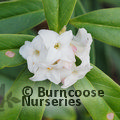
DAPHNE bholua 'Garden House Ghost'
heavily scented white flowers in winter


DAPHNE bholua 'Jacqueline Postill'
large and showy intensely fragrant purplish pink flowers

DAPHNE bholua 'Limpsfield'
purple-pink in bud, opening paler with white to purple tones. Richly scented and floriferous

DAPHNE bholua 'Mary Rose'
deep purple-pink, darker in bud. Comparatively large flowers and highly scented
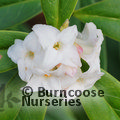
DAPHNE bholua 'Spring Herald'
pure white flowers on this early flowering and highly scented shrub
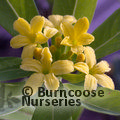
DAPHNE gemmata
bushy habit and clusters of yellow flowers in late spring to summer followed by red fruits

DAPHNE laureola subsp. philippi
fragrant yellow-green flowers beneath polished green leaves. Semi-prostrate habit

DAPHNE mezereum 'Rubra'
scented purplish-red flowers
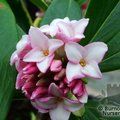
DAPHNE odora
fragrant with reddish-purple flowers
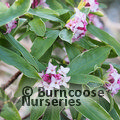
DAPHNE odora 'Aureomarginata'
leaves have a yellow margin which becomes creamy-white with age

DAPHNE odora f.alba
(var leucantha) - pure white flowered form
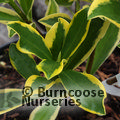
DAPHNE odora 'Mae-jima'
compact habit and attractive creamy-yellow edged green leaves. Profuse dark pink, strongly fragrant flowers
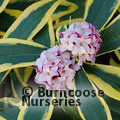
DAPHNE odora 'Marianni'
('Rogbret'). - green leaves with broad golden yellow margins. Very fragrant tubular pink flowers in late winter, early spring
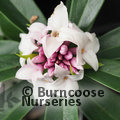
DAPHNE 'Perfume Princess'
large clusters of very fragrant white flowers with a hint of pink at the centre
Useful extras...








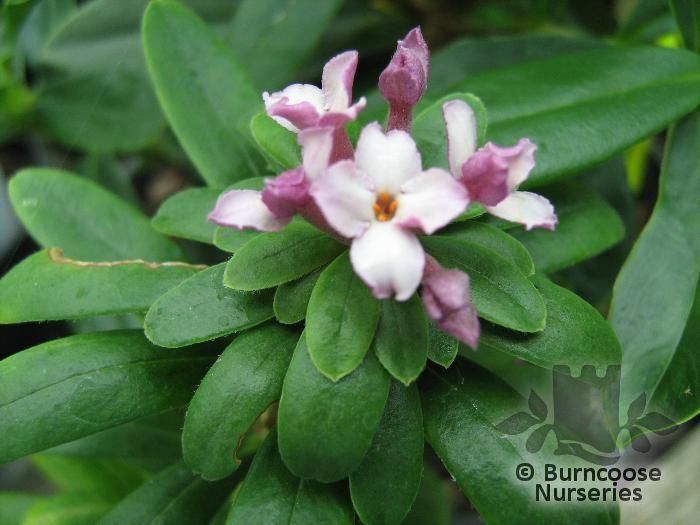





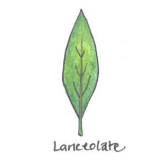
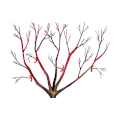
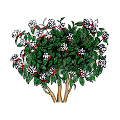







 Gift-wrapping available
Gift-wrapping available




